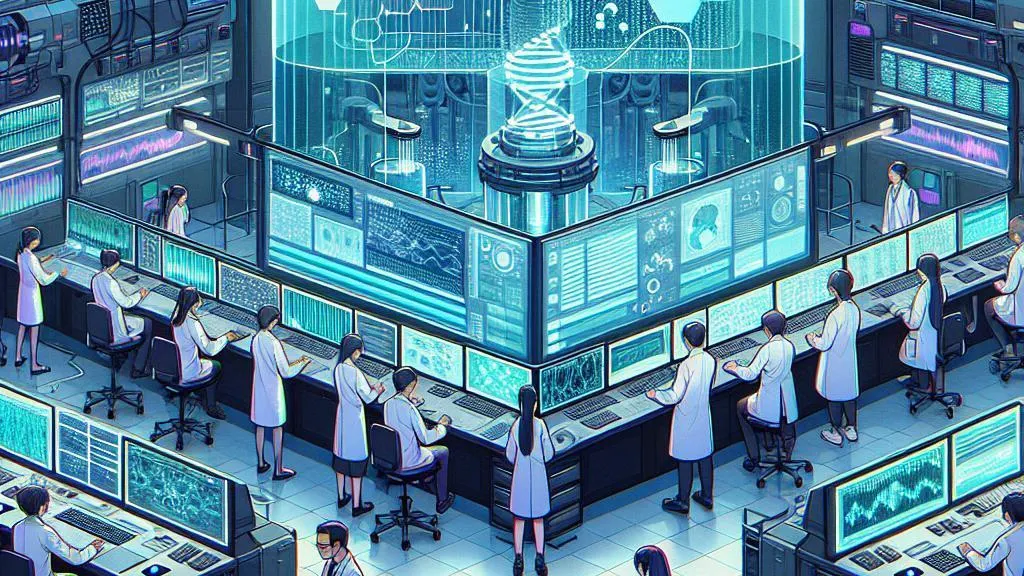How does AI even generate content?
Welcome to the future, folks! There’s a digital revolution happening, and it's shaking the foundations …

Today, I want to explore the fascinating world of massive parallel sequencing and how AI is revolutionising this field. It has opened up new avenues for understanding diseases, developing targeted therapies, and advancing personalised medicine.
However, the sheer volume and complexity of the data generated by these sequencing technologies can be overwhelming. That's where AI comes in, offering powerful tools to streamline data analysis and extract meaningful insights.

Before we discuss how AI transforms massive parallel sequencing, let's define artificial intelligence. At its core, AI refers to the development of computer systems that can perform tasks typically requiring human intelligence, such as learning, problem-solving, and pattern recognition. These systems leverage algorithms and statistical models to analyse vast data, identify patterns, and make predictions or decisions.
Now, let's explore how AI is being applied in the context of massive parallel sequencing. One of the key challenges in sequencing data analysis is the sheer volume of data generated. A single sequencing run can produce billions of short DNA fragments, known as reads, which must be pieced together like a gigantic puzzle to reconstruct the original genome. This process, called alignment, is computationally intensive and time-consuming.
AI algorithms, such as deep learning neural networks, can significantly accelerate alignment by learning patterns and making intelligent predictions about where each read belongs in the genome.
But alignment is just the beginning. Once the reads are mapped, the next step is identifying genetic variations, such as single nucleotide polymorphisms (SNPs) or structural variations, that may be associated with specific traits or diseases.
This process, known as variant calling, involves comparing the sequenced genome to a reference genome and detecting differences. AI algorithms can enhance variant calling by learning from large datasets of known variants and applying that knowledge to identify novel or rare variants with higher accuracy.
The integration of AI in massive parallel sequencing brings forth numerous benefits. First and foremost, AI can significantly reduce the time and computational resources required for data analysis. By automating complex tasks and leveraging the power of machine learning, researchers can process sequencing data much faster, enabling them to focus on interpreting the results and deriving biological insights.
AI can improve the accuracy and reliability of sequencing data analysis. Traditional bioinformatics pipelines often rely on predefined rules and heuristics, which may not capture the full complexity of the data. AI algorithms, on the other hand, can learn from large datasets and adapt to the specific characteristics of each sequencing experiment, leading to more precise and robust results.
Another significant benefit of AI in massive parallel sequencing is its potential to uncover novel insights and patterns that may be difficult for humans to discern. By analysing vast amounts of sequencing data across different populations and conditions, AI can identify subtle associations and correlations that may have gone unnoticed. This can lead to the discovery of new disease mechanisms, drug targets, or biomarkers, accelerating the development of personalised therapies and diagnostic tools.

Despite AI's immense potential in massive parallel sequencing, there are also challenges and limitations to consider. One major challenge is the need for large, high-quality datasets to train AI models effectively. Sequencing data can be noisy, with errors and biases introduced during sample preparation, sequencing, and data processing. Ensuring the quality and consistency of training data is crucial for developing reliable AI algorithms.
Another concern is the potential for bias in AI algorithms. AI models may perpetuate or amplify existing biases if the training data does not represent the diverse human population. It is essential to actively address issues of diversity, equity, and inclusion in AI development and validation to ensure that the benefits of these technologies are distributed fairly.
Looking ahead, the future of AI in massive parallel sequencing is brimming with possibilities. As sequencing technologies advance and become more affordable, the amount of genomic data available for analysis will only grow. This presents an incredible opportunity for AI to unlock new insights and accelerate scientific discoveries.
One exciting avenue is the development of new AI algorithms specifically tailored for massive parallel sequencing data. Researchers can create more sophisticated models that can handle the complexities and nuances of genomic data by leveraging techniques such as deep learning, transfer learning, and reinforcement learning.
Another promising direction is the integration of AI into clinical applications. As genomic sequencing becomes more widely adopted in healthcare settings, AI can be crucial in interpreting patient data and guiding clinical decision-making. By combining genomic information with other clinical and omics data, AI algorithms can provide personalised risk assessments, treatment recommendations, and prognostic predictions, enabling precision medicine at an unprecedented scale.
In conclusion, integrating AI in massive parallel sequencing is a game-changer for genomics research. By leveraging the power of machine learning and big data analytics, AI is transforming how we process, analyse, and interpret sequencing data. From accelerating alignment and variant calling to uncovering novel insights and patterns, AI empowers researchers to unlock the full potential of genomic information.
As we continue to navigate AI's challenges and limitations in this field, it is crucial to foster collaboration between computational scientists, biologists, and clinicians. By working together, we can harness the synergy of AI and massive parallel sequencing to advance our understanding of the genome, develop targeted therapies, and ultimately improve human health.
So, let's embrace AI's exciting possibilities to massive parallel sequencing and embark on this transformative journey together. The future of genomics is here, and with AI by our side, the possibilities are endless!
Thank you for joining me on this exploration of AI in massive parallel sequencing. Until next time, keep exploring, innovating, and pushing the boundaries of what's possible in genomics research!
Some other posts you may like

How does AI even generate content?
Welcome to the future, folks! There’s a digital revolution happening, and it's shaking the foundations …
July 16, 2024
Read More
Which AI Company To Invest In?
In the fast-paced digital world that we're reveling in, it feels like we’re on the …
July 16, 2024
Read More